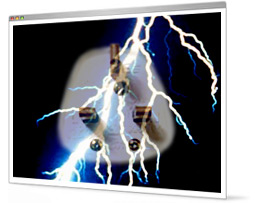My UPD8
You need to login before you download the free activities. You can register here.
- The Centre for Science Education
- The Association for Science Education
- Partners
- Part of ASE online
Charge!

Type: Activity
Learning Strategy: Case study
Topic: Energy transfer
Mobiles, cameras and music players all have their own chargers. These anonymous black boxes clutter our homes and are easy to lose. But this modern hassle could soon become a thing of the past. Instead of each device needing its own charger, we may soon be able to recharge them just by putting them on a plastic-coated pad the size of a mouse mat – a SplashPad. In this activity, students learn how SplashPad works and cut and stick labels to explain it to a potential investor.
Published: 2nd February 2005
Reviews & Comments: 3
Learning objectives
Students will describe energy transfers in transformers ('chargers')
Try the activity
Please login to download activities
Curriculum link
� Magnets and electromagnets [QCA 8j] – use the concept of magnetic field� Energy and electricity [QCA 9i] – useful changes usually involved energy transfers and transformations; electrical energy is transferred round circuits and can be transformed in components; identify devices that act as energy stores; a simple model of energy transfer from batteries to components in circuits; cells have chemical energy
Running the activity
Suggested time: 20 minutes
Possible starter:
Set the scene by displaying page 1 on OHT or by projector. This page makes the point – through a text message conversation – that many of us have a great number of chargers at home, each compatible with only one device. But help is at hand! A universal charger – SplashPad – has just been invented.
Main activity:
Give each small group copies of pages 2 and 3. In the context of helping a person to decide whether or not to invest in SplashPad, students cut and stick labels to show how conventional mobile chargers and SplashPad work.
Web links
News links
- New Scientist
- iThis is an article announcing the proposed new device and giving some of the technical details
- SplashPower
- This is the web site of the company planning to produce the mats
- HowStuffWorks
- This explains how an electric toothbrush works – the science involved is very similar to that of SplashPad
Reviews & Comments
Write your online review to share your feedback and classroom tips with other teachers. How well does it work, how engaging is it, how did you use it, and how could it be improved?
Charge! review
Oct 22nd, 2009

I have a very low ability Yr 9 class. They enjoy science but their main problem is writing. They were able to put most of the statements in the right place and they could manage the energy transfers.
The transformer was beyond them but the fact that the activity was simply worded and they did not need to write anything meant that they could access the science easily.
I then put the sheet up on the interactive whiteboard and we wrote the answers on it so they could check their work. They all finished both sheets and loved translating the first page for me!
Reviewer: Rachel Harris
PLAY PUMP
Sep 4th, 2008

This is one of the most direct and yet robust activities on solar energy. A complete project that would engage the students across all levels and provide cross curricular links - maths, citizenship etc
Great tool!
Reviewer: OLUWATOYIN LADITI
Charge!
Mar 7th, 2005

A very cool idea as far as a very able year 8 was concerned. She found the activity difficult but she attempted it well and perhaps a year 9 would do better.
However, teaching in a truly comprehensive school I feel that the ideas of transformers/changing magnetic fields are a little confusing for year 9's and better suited to year 11s.
The activity itself is well written but some of the answers are very similar and may need careful explanation.
Reviewer: catherine Serrao

200 lessons and assessments from as little as £4.95
Related Activities
Physics / Energy transfer
Difficult & Dull / Electricity & Magnetism
- Bulb danger
- Australian light bulb ban
- Poo power or nuclear power?
- Riches from the Wind
- Appliance science
QCA / 9I Energy & electricity
- Bulb danger
- Riches from the Wind
- So windy
- Australian light bulb ban
- Poo power or nuclear power?
- Play Pump
- Think big
- Appliance science
Learning Strategy / Case study
- False diamonds
- Life for a life
- Ellen's moments
- Deadly Dengue
- New deal for diabetics
- Art Attack
- Faulkes Telescope free courses
- Moon mission 2020
- Physics idol
- Solar roadways
- Sinking island
- Bird flu - can science save us?
- Ulcer bug breakthrough
- Bionic Vision
- Top Dog
- Here comes the sun
- Ban Wi-Fi?
- Is it terminal for Teflon?
- Is Glastonbury Sustainable?
- Cannabis
- test
- Sports clinic
- Leaning tower
- Robot explorer
- Ebola
- Addicted to energy
- Barn fire
- In the limelight
- One of our scientists is missing
- Think big
- Electronic patient records
- Grow your own body
- Ban cola?
- Attack of the giant viruses
- Car wars
- Eat insects
- Appliance science
- Chocolate money
- Big bag ban
- GM decisions
- Text neck
- Invasion!
- Life on Enceladus?